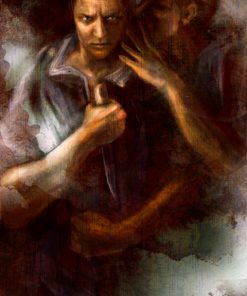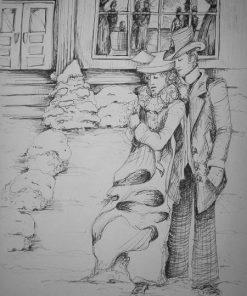Free Education Guide!
Teachers and educators, download our free PDF education guide for this show, which will help you incorporate Chatterbox into your classroom!
Written by Karen Strachan.
Cast & Crew
Narrator: Iris Laverdant
Mathilde Loisel: Laura Loth
Monsieur Loisel: Alex Novikoff
Madame Forestier: Margaret McColley
Musician: Katherine Whitfield
Sound Effects: Margaret McColley
Producer: Robert Arnold
Adaptation: Shira Malkin
Adaptation: Karen Strachan
Director: Shira Malkin
Director: Karen Strachan
Artist: Robert Arnold
Notes
Spoiler alert! Don’t read these notes if you don’t want the ending of the story revealed.
Guy de Maupassant (1850-1893) perfected the form of the modern short story. “The Necklace” (in French “La Parure”) was first published in 1884 in the French daily newspaper Le Gaulois and became an instant hit because of its unexpected final twist. Henry James was inspired to reverse its original plot in a story entitled “Paste” (1899). Irish composer Conor Mitchell turned it into Mathilde, a musical first produced professionally by Thomas Hopkins and Andrew Jenkins for Surefire Theatrical at the Edinburgh Festival Fringe in 2008.
The highbrow public of the second half of the 19th-century resisted the representation of the lower classes in literature and art. This was due in part to the rise of capitalism and the rigid division of French society into three distinct groups. At the top, the haute bourgeoisie flaunted its wealth, privilege, and power just like the aristocracy had done before the French Revolution of 1789. At the other extreme, the exploited and dreaded masses toiled away in poverty and squalor, whether urban proletariat or rural farm hands. And in between, the petty (or more accurately, the petite) bourgeoisie held modest jobs, with no hope of ever achieving upward social mobility. It is that particular segment of the population made up of shopkeepers, office employees, and low-grade civil servants that Maupassant targets in “The Necklace.”
Maupassant’s characters are not free agents. While they are fate’s puppets (Mathilde is keenly aware she was born in the wrong caste), they are also the products of their own time and place. Mathilde’s longings for a finer, more exciting life echo those of Flaubert’s hapless heroine Emma Bovary and underscore women’s place in 19th century France. This was a time when it was believed that women’s brains were inferior to men’s and that one should not bother educating them. Bourgeois girls were sent to convent schools for a year or two to be groomed to become good, proper wives. They learned how to read and write. They also received a religious education and were taught basic math and needlepoint. Besides creating obedient models of domesticity, however, convent schools also played an important role in the social dynamic by allowing young women of different backgrounds to make lasting connections across the class divide (compulsory military service did the same for young men). In the case of Mathilde, it is significant that convent school is where she met Jeanne Forestier, the rich friend who lends her the necklace that will change her life. It is also noteworthy that, although Jeanne regularly invites Mathilde to her luxurious house in the name of their bond, the visits prove too painful for her former classmate. Faced with the stark gap between their two worlds, Mathilde feels so humiliated that she decides to stop calling on her friend.
From this simple premise (class difference), Maupassant skillfully crafts a tight narrative that moves us efficiently toward an inexorable conclusion. Using a familiar story-telling pattern, Maupassant contrasts Mathilde’s Cinderella-like transformation before the party and her intoxicating success at the ball wearing Jeanne’s diamond necklace with the Loisels’ incremental descent into their reality once the night is over. That much could be expected. But there is more. Maupassant vividly recreates the frigid night air, Mathilde’s shabby coat, the drab hackney cab bringing them home on the aptly named rue des Martyrs only to lead them to a grim realization. The borrowed necklace is lost and must be replaced, at great cost.
Maupassant’s cautionary tale of transgression stresses in great detail the economic and social punishment the Loisels must undergo for having overstepped the limits of their station. But it also highlights how efficiently each class has been socialized to behave along certain immutable codes. The shame Mathilde experiences with regard to Jeanne, her inability to overcome the stigma of possibly being labeled a thief, overrides the fact that the loss of the necklace is an accident, that she is innocent, and that she could confess the truth to her friend. Out of pride, she says nothing. Instead, the Loisels become martyrs to their internalized sense of propriety. They dutifully and bravely endure a ten-year ordeal that will degrade them from lower middle class to working class status in order to repay their debt in full. Once his characters are in the clear, however, Maupassant is not interested in letting them enjoy their sense of redemption in peace. He has another point to make.
Having brilliantly condensed a decade of sacrifice in one page, Maupassant leads both the heroine and the reader to the real punch line: the Loisels’ decade-long sacrifice was for naught, the necklace was false. Here, readers fluent in French can appreciate the writer’s clever choice of “La Parure” for the title. Maupassant could have used “Le Collier,” which also means “The Necklace,” instead. But parure suggests a far more valuable jewel than the common term collier and underscores the devastating impact of Jeanne’s news. In this dramatic final twist, Maupassant reveals that the real stakes of class inequality are as brutal and arbitrary as they are absurd.
With Chatterbox Audio Theater’s first-ever bilingual recording, it is hoped that French and English speakers alike will appreciate this timeless (and timely) masterpiece at its full value.
—Shira Malkin












Reviews
There are no reviews yet.